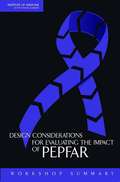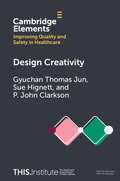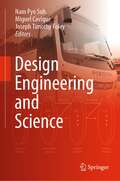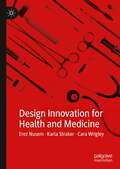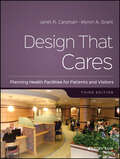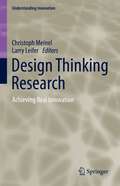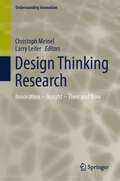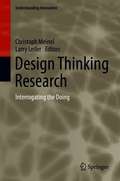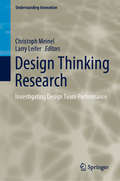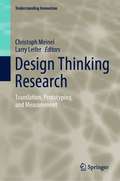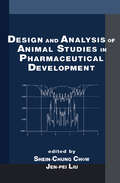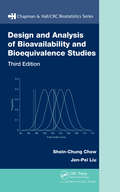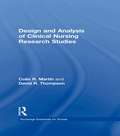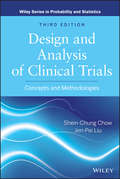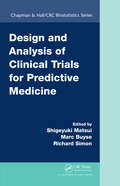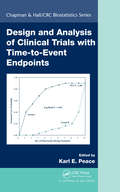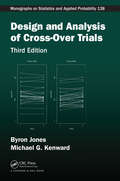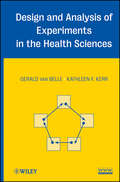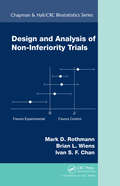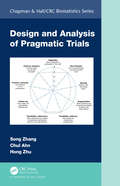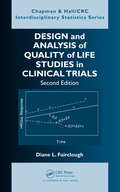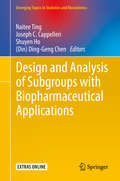- Table View
- List View
Design Considerations For Evaluating The Impact Of Pepfar: Workshop Summary
by Institute of Medicine of the National AcademiesDesign Considerations for Evaluating the Impact of PEPFAR is the summary of a 2-day workshop on methodological, policy, and practical design considerations for a future evaluation of human immunodeficiency virus/acquired immunodeficiency syndrome (HIV/AIDS) interventions carried out under the President’s Emergency Plan for AIDS Relief (PEPFAR), which was convened by the Institute of Medicine (IOM) on April 30 and May 1, 2007. Participants at the workshop included staff of the U.S. Congress; PEPFAR officials and implementers; major multilateral organizations such as The Global Fund to Fight AIDS, Malaria, and Tuberculosis (The Global Fund), the Joint United Nations Programme on HIV/AIDS (UNAIDS), and the World Bank; representatives from international nongovernmental organizations; experienced evaluation experts; and representatives of partner countries, particularly the PEPFAR focus countries. The workshop represented a final element of the work of the congressionally mandated IOM Committee for the Evaluation of PEPFAR Implementation, which published a report of its findings in 2007 evaluating the first 2 years of implementation, but could not address longer term impact evaluation questions.
Design Controls for the Medical Device Industry, Third Edition
by Marie B. TeixeiraThis third edition provides a substantial comprehensive review of the latest design control requirements, as well as proven tools and techniques to ensure a company's design control program evolves in accordance with current industry practice. It assists in the development of an effective design control program that not only satisfies the US FDA Quality Systems Regulation (QSR) and 13485:2016 standards, but also meets today's Notified Body Auditors' and FDA Investigators' expectations. The book includes a review of the design control elements such as design planning, input, output, review, verification, validation, change, transfer, and history, as well as risk management inclusive of human factors and usability, biocompatibility, the FDA Quality System Inspection Technique (QSIT) for design controls, and medical device regulations and classes in the US, Canada, and Europe. Practical advice, methods and appendixes are provided to assist with implementation of a compliant design control program and extensive references are provided for further study. This third edition: Examines new coverage of ISO 13485-2016 design control requirements Explores proven techniques and methods for compliance Contributes fresh templates for practical implementation Provides updated chapters with additional details for greater understanding and compliance Offers an easy to understand breakdown of design control requirements Reference to MDSAP design control requirements
Design Creativity (Elements of Improving Quality and Safety in Healthcare)
by Gyuchan Thomas Jun Sue Hignett P. John ClarksonDesign creativity describes the process by which needs are explored and translated into requirements for change. This Element examines the role of design creativity within the context of healthcare improvement. It begins by outlining the characteristics of design thinking, and the key status of the Double Diamond Model. It provides practical tools to support design creativity, including ethnographic/observational studies, personas and scenarios, and needs identification and requirements analysis. It also covers brainstorming, Disney, and six thinking hats techniques, the nine windows technique, morphological charts and product architecting, and concept evaluation. The tools, covering all stages of the Double Diamond model, are supported by examples of their use in healthcare improvement. The Element concludes with a critique of design creativity and the evidence for its application in healthcare improvement. This title is also available as Open Access on Cambridge Core.
Design Engineering and Science
by Nam Pyo Suh Miguel Cavique Joseph Timothy FoleyDesign Engineering and Science teaches the theory and practice of axiomatic design (AD). It explains the basics of how to conceive and deliver solutions to a variety of design problems. The text shows how a logical framework and scientific basis for design can generate creative solutions in many fields, including engineering, materials, organizations, and a variety of large systems.Learning to apply the systematic methods advocated by AD, a student can construct designs that lead to better environmental sustainability and to increased quality of life for the end-user at the same time reducing the overall cost of the product development process. Examples of previous innovations that take advantage of AD methods include:• on-line electric vehicle design for electric buses with wireless power supply;• mobile harbors that allow unloading of large ships in shallow waters;• microcellular plastics with enhanced toughness and lower weight; and• organizational changes in companies and universities resulting in more efficient and competitive ways of working.The book is divided into two parts. Part I provides detailed and thorough instruction in the fundamentals of design, discussing why design is so important. It explains the relationship between and the selection of functional requirements, design parameters and process variables, and the representation of design outputs. Part II presents multiple applications of AD, including examples from manufacturing, healthcare, and materials processing.Following a course based on this text students learn to create new products and design bespoke manufacturing systems. They will gain insight into how to create imaginative design solutions that satisfy customer needs and learn to avoid introducing undue complexity into their designs. This informative text provides practical and academic insight for engineering design students and will help instructors teach the subject in a novel and more rigorous fashion. Their knowledge of AD will stand former students in good stead in the workplace as these methods are both taught and used in many leading industrial concerns.
Design Innovation for Health and Medicine
by Cara Wrigley Karla Straker Erez NusemDesign Innovation for Health and Medicine offers an innovative approach for solving complex healthcare issues. In this book, three design experts examine a range of case studies to explain how design is used in health and medicine—exploring issues such as diverse patient needs, an ageing population and the impact of globalisation on disease. These case studies, along with high-profile industry projects conducted by the authors over the past decade, inform a novel framework for designing and implementing innovative solutions in this context. The book aims to assist designers, medical engineers, clinicians and researchers to shape the next era of healthcare.
Design That Cares: Planning Health Facilities for Patients and Visitors (Third Edition)
by Myron A. Grant Janet R. CarpmanDesign That Cares: Planning Health Facilities for Patients and Visitors, 3rd Edition is the award-winning, essential textbook and guide for understanding and achieving customer-focused, evidence-based health care design excellence. This updated third edition includes new information about how all aspects of health facility design - site planning, architecture, interiors, product design, graphic design, and others - can meet the needs and reflect the preferences of customers: patients, family and visitors, as well as staff. The book takes readers on a journey through a typical health facility and discusses, in detail, at each stop along the way, how design can demonstrate care both for and about patients and visitors. Design that Cares provides the definitive roadmap to improving customer experience by design.
Design Thinking Research: Achieving Real Innovation (Understanding Innovation)
by Christoph Meinel Larry LeiferExtensive research conducted by the Hasso Plattner Design Thinking Research Program at Stanford University in Palo Alto, California, USA, and the Hasso Plattner Institute in Potsdam, Germany, has yielded valuable insights on why and how design thinking works. The participating researchers have identified metrics, developed models, and conducted studies, which are featured in this book, and in the previous volumes of this series. This volume provides readers with tools to bridge the gap between research and practice in design thinking with varied real world examples. Several different approaches to design thinking are presented in this volume. Acquired frameworks are leveraged to understand design thinking team dynamics. The contributing authors lead the reader through new approaches and application fields and show that design thinking can tap the potential of digital technologies in a human-centered way. It also presents new ideas in neurodesign from Stanford University and the Hasso Plattner Institute in Potsdam, inviting the reader to consider newly developed methods and how these insights can be applied to different domains. Design thinking can be learned. It has a methodology that can be observed across multiple settings and accordingly, the reader can adopt new frameworks to modify and update existing practice. The research outcomes compiled in this book are intended to inform and provide inspiration for all those seeking to drive innovation – be they experienced design thinkers or newcomers.
Design Thinking Research: Innovation – Insight – Then and Now (Understanding Innovation)
by Christoph Meinel Larry LeiferExtensive research conducted at the Hasso Plattner Design Thinking Research Program at Stanford University in Palo Alto, California, USA, and at the Hasso Plattner Institute in Potsdam, Germany, has yielded valuable insights on why and how design thinking works. The participating researchers have identified metrics, developed models, and conducted studies, which are featured in this book and in the previous volumes of this series. This volume provides readers with tools to bridge the gap between research and practice in design thinking, together with a range of real-world examples. Several different approaches to design thinking are presented, while acquired frameworks are employed to understand team dynamics in design thinking. The contributing authors introduce readers to new approaches and fields of application and show how design thinking can tap the potential of digital technologies in a human-centered way. The book also presents new ideas on neuro-design from Stanford University and the Hasso Plattner Institute in Potsdam, inviting readers to consider newly developed methods and how these insights can be applied to different domains. Design thinking can be learned. It has a methodology that can be observed across multiple settings. Accordingly, readers can adopt new frameworks to modify and update their current practices. The research outcomes gathered here are intended to inform and provide inspiration for all those seeking to drive innovation – be they experienced design thinkers or newcomers. It is the last in a series of 14 volumes published over the past 14 years, reflecting the successes of the HPI-Stanford Design Thinking Research Program. Many thanks to the Hasso Plattner Foundation for its valued support.
Design Thinking Research: Interrogating the Doing (Understanding Innovation)
by Christoph Meinel Larry LeiferExtensive research conducted by the Hasso Plattner Design Thinking Research Program at Stanford University in Palo Alto, California, USA, and the Hasso Plattner Institute in Potsdam, Germany, has yielded valuable insights on why and how design thinking works. The participating researchers have identified metrics, developed models, and conducted studies, which are featured in this book, and in the previous volumes of this series. This volume provides readers with tools to bridge the gap between research and practice in design thinking with varied real world examples. Several different approaches to design thinking are presented in this volume. Acquired frameworks are leveraged to understand design thinking team dynamics. The contributing authors lead the reader through new approaches and application fields and show that design thinking can tap the potential of digital technologies in a human-centered way. In a final section, new ideas in neurodesign at Stanford University and at Hasso Plattner Institute in Potsdam are elaborated upon thereby challenging the reader to consider newly developed methodologies and provide discussion of how these insights can be applied to various sectors. Special emphasis is placed on understanding the mechanisms underlying design thinking at the individual and team levels. Design thinking can be learned. It has a methodology that can be observed across multiple settings and accordingly, the reader can adopt new frameworks to modify and update existing practice. The research outcomes compiled in this book are intended to inform and provide inspiration for all those seeking to drive innovation – be they experienced design thinkers or newcomers.
Design Thinking Research: Investigating Design Team Performance (Understanding Innovation)
by Christoph Meinel Larry LeiferExtensive research conducted by the Hasso Plattner Design Thinking Research Program at Stanford University in Palo Alto, California, USA, and the Hasso Plattner Institute in Potsdam, Germany, has yielded valuable insights on why and how design thinking works. The participating researchers have identified metrics, developed models, and conducted studies, which are featured in this book, and in the previous volumes of this series.Offering readers a closer look at design thinking, and its innovation processes and methods, this volume addresses the new and growing field of neurodesign, which applies insights from the neurosciences in order to improve design team performance. Thinking and devising innovations are inherently human activities – and so is design thinking. Accordingly, design thinking is not merely the result of special courses or of being gifted or trained: it is a way of dealing with our environment and improving techniques, technologies and life in general. As such, the research outcomes compiled in this book are intended to inform and provide inspiration for all those seeking to drive innovation – be they experienced design thinkers or newcomers.
Design Thinking Research: Translation, Prototyping, and Measurement (Understanding Innovation)
by Christoph Meinel Larry LeiferExtensive research conducted by the Hasso Plattner Design Thinking Research Program at Stanford University in Palo Alto, California, USA, and the Hasso Plattner Institute in Potsdam, Germany, has yielded valuable insights on why and how design thinking works. The participating researchers have identified metrics, developed models, and conducted studies, which are featured in this book, and in the previous volumes of this series. This volume provides readers with tools to bridge the gap between research and practice in design thinking with varied real world examples. Several different approaches to design thinking are presented in this volume. Acquired frameworks are leveraged to understand design thinking team dynamics. The contributing authors lead the reader through new approaches and application fields and show that design thinking can tap the potential of digital technologies in a human-centered way. In a final section, new ideas in neurodesign at Stanford University and at Hasso Plattner Institute in Potsdam are elaborated upon thereby challenging the reader to consider newly developed methodologies and provide discussion of how these insights can be applied to various sectors. Special emphasis is placed on understanding the mechanisms underlying design thinking at the individual and team levels. Design thinking can be learned. It has a methodology that can be observed across multiple settings and accordingly, the reader can adopt new frameworks to modify and update existing practice. The research outcomes compiled in this book are intended to inform and provide inspiration for all those seeking to drive innovation – be they experienced design thinkers or newcomers.
Design Thinking in Healthcare: From Problem to Innovative Solutions
by Anni Pakarinen Thomas Lemström Eeva Rainio Eriikka SiiralaThis book offers basic knowledge on Design Thinking as a method, process and philosophy. It presents thoughtful Design Thinking case examples and tools for nurses and other healthcare professionals, researchers, students and educators to support their development as creative and transformative leaders in their fields.Healthcare managers of the past viewed patients’ needs merely as targets for population-level health outcomes to be validated in the final phases of developing interventions and services. Today we know better. Patients’ needs and experiences should be viewed as sources of innovation at the front-end of the development process. It provides the basis for applying design thinking to develop better healthcare services and health tech applications.Today, the success of any healthcare service depends on complex interactions between various stakeholders, and new solutions can only be delivered effectively through co-creative and collaborative efforts. Coordinating such efforts relies on strong concepts that can only result from properly run design processes, that this book describes in light of case studies around the world.Design thinking is crucial generalist skill and is receiving increasing attention in the field, as forward-thinking organizations delve into the practice. It can change the way medical solutions are created and how clinical services are delivered. By driving innovation by means of empathy and practicality, design thinking provides tools for those seeking to drive radical renewal in the field.
Design and Analysis of Animal Studies in Pharmaceutical Development (Chapman & Hall/CRC Biostatistics Series)
by Shein-Chung Chow"Provides well-integrated, comprehensive coverage of all the major statistical designs and methods used for animal studies in pharmaceutical research and development. Demonstrates the correct way to interpret the results of animal studies in the risk assessment of biopharmaceutical products and clarifies detailed presentations with real-world examp
Design and Analysis of Bioavailability and Bioequivalence Studies (Chapman & Hall/CRC Biostatistics Series)
by Shein-Chung Chow Jen-pei LiuPreeminent Experts Update a Well-Respected BookTaking into account the regulatory and scientific developments that have occurred since the second edition, Design and Analysis of Bioavailability and Bioequivalence Studies, Third Edition provides a complete presentation of the latest progress of activities and results in bioavailability and bioequiva
Design and Analysis of Bridging Studies (Chapman & Hall/CRC Biostatistics Series)
by Shein-Chung Chow Jen-Pei Liu Chin-Fu HsiaoAs the development of medicines has become more globalized, the geographic variations in the efficacy and safety of pharmaceutical products need to be addressed. To accelerate the product development process and shorten approval time, researchers are beginning to design multiregional trials that incorporate subjects from many countries around the w
Design and Analysis of Clinical Nursing Research Studies (Routledge Essentials for Nurses)
by Colin R Martin David R ThompsonThis invaluable text on the design and analysis of clinical research studies explains the basis of experimental design and statistics in a way that is sensitive to the clinical context in which nurses work. It uses data from actual studies to illustrate how to:*design the study*use and select data*present research findings*use a computer for statistical analysis.The scope of the study designs and associated statistical techniques covered in the book allow both the beginning nurse researcher and the more seasoned professional nurse investigator to approach a research study with confidence and optimism. The authors show how qualitative data can be approached quantitatively, what the advantages of this are from the nursing viewpoint, and how quantitative methodology can help nurses to develop a common research language with other disciplines involved in patient care.
Design and Analysis of Clinical Trials
by Shein-Chung Chow Jen-Pei LiuThe Third Edition of Design and Analysis of Clinical Trials provides complete, comprehensive, and expanded coverage of recent health treatments and interventions. Featuring a unified presentation, the book provides a well-balanced summary of current regulatory requirements and recently developed statistical methods as well as an overview of the various designs and analyses that are utilized at different stages of clinical research and development. Additional features of this Third Edition include:* New chapters on biomarker development and target clinical trials, adaptive design, trials for evaluating diagnostic devices, statistical methods for translational medicine, and traditional Chinese medicine* A balanced overview of current and emerging clinical issues as well as newly developed statistical methodologies* Practical examples of clinical trials that demonstrate everyday applicability, with illustrations and examples to explain key concepts* New sections on bridging studies and global trials, QT studies, multinational trials, comparative effectiveness trials, and the analysis of QT/QTc prolongation* A complete and balanced presentation of clinical and scientific issues, statistical concepts, and methodologies for bridging clinical and statistical disciplines* An update of each chapter that reflects changes in regulatory requirements for the drug review and approval process and recent developments in statistical design and methodology for clinical research and development. Design and Analysis of Clinical Trials, Third Edition continues to be an ideal clinical research reference for academic, pharmaceutical, medical, and regulatory scientists/researchers, statisticians, and graduate-level students.
Design and Analysis of Clinical Trials for Predictive Medicine (Chapman & Hall/CRC Biostatistics Series)
by Richard Simon Shigeyuki Matsui Marc BuyseDesign and Analysis of Clinical Trials for Predictive Medicine provides statistical guidance on conducting clinical trials for predictive medicine. It covers statistical topics relevant to the main clinical research phases for developing molecular diagnostics and therapeutics-from identifying molecular biomarkers using DNA microarrays to confirming
Design and Analysis of Clinical Trials with Time-to-Event Endpoints (Chapman & Hall/CRC Biostatistics Series)
by Karl E. PeaceUsing time-to-event analysis methodology requires careful definition of the event, censored observation, provision of adequate follow-up, number of events, and independence or "noninformativeness" of the censoring mechanisms relative to the event. Design and Analysis of Clinical Trials with Time-to-Event Endpoints provides a thorough presentation o
Design and Analysis of Cross-Over Trials (ISSN)
by Byron Jones Michael G. KenwardDesign and Analysis of Cross-Over Trials is concerned with a specific kind of comparative trial known as the cross-over trial, in which subjects receive different sequences of treatments. Such trials are widely used in clinical and medical research, and in other diverse areas such as veterinary science, psychology, sports science, and agriculture.T
Design and Analysis of Experiments in the Health Sciences
by Gerald Van Belle Kathleen F. KerrAn accessible and practical approach to the design and analysis of experiments in the health sciencesDesign and Analysis of Experiments in the Health Sciences provides a balanced presentation of design and analysis issues relating to data in the health sciences and emphasizes new research areas, the crucial topic of clinical trials, and state-of-the- art applications.Advancing the idea that design drives analysis and analysis reveals the design, the book clearly explains how to apply design and analysis principles in animal, human, and laboratory experiments while illustrating topics with applications and examples from randomized clinical trials and the modern topic of microarrays. The authors outline the following five types of designs that form the basis of most experimental structures:Completely randomized designsRandomized block designsFactorial designsMultilevel experimentsRepeated measures designsA related website features a wealth of data sets that are used throughout the book, allowing readers to work hands-on with the material. In addition, an extensive bibliography outlines additional resources for further study of the presented topics.Requiring only a basic background in statistics, Design and Analysis of Experiments in the Health Sciences is an excellent book for introductory courses on experimental design and analysis at the graduate level. The book also serves as a valuable resource for researchers in medicine, dentistry, nursing, epidemiology, statistical genetics, and public health.
Design and Analysis of Non-Inferiority Trials (Chapman & Hall/CRC Biostatistics Series)
by Mark D. Rothmann Brian L. Wiens Ivan S.F. ChanThe increased use of non-inferiority analysis has been accompanied by a proliferation of research on the design and analysis of non-inferiority studies. Using examples from real clinical trials, Design and Analysis of Non-Inferiority Trials brings together this body of research and confronts the issues involved in the design of a non-inferiority tr
Design and Analysis of Pragmatic Trials (Chapman & Hall/CRC Biostatistics Series)
by Hong Zhu Song Zhang Chul AhnThis book begins with an introduction of pragmatic cluster randomized trials (PCTs) and reviews various pragmatic issues that need to be addressed by statisticians at the design stage. It discusses the advantages and disadvantages of each type of PCT, and provides sample size formulas, sensitivity analyses, and examples for sample size calculation. The generalized estimating equation (GEE) method will be employed to derive sample size formulas for various types of outcomes from the exponential family, including continuous, binary, and count variables. Experimental designs that have been frequently employed in PCTs will be discussed, including cluster randomized designs, matched-pair cluster randomized design, stratified cluster randomized design, stepped-wedge cluster randomized design, longitudinal cluster randomized design, and crossover cluster randomized design. It demonstrates that the GEE approach is flexible to accommodate pragmatic issues such as hierarchical correlation structures, different missing data patterns, randomly varying cluster sizes, etc. It has been reported that the GEE approach leads to under-estimated variance with limited numbers of clusters. The remedy for this limitation is investigated for the design of PCTs. This book can assist practitioners in the design of PCTs by providing a description of the advantages and disadvantages of various PCTs and sample size formulas that address various pragmatic issues, facilitating the proper implementation of PCTs to improve health care. It can also serve as a textbook for biostatistics students at the graduate level to enhance their knowledge or skill in clinical trial design. Key Features: Discuss the advantages and disadvantages of each type of PCTs, and provide sample size formulas, sensitivity analyses, and examples. Address an unmet need for guidance books on sample size calculations for PCTs; A wide variety of experimental designs adopted by PCTs are covered; The sample size solutions can be readily implemented due to the accommodation of common pragmatic issues encountered in real-world practice; Useful to both academic and industrial biostatisticians involved in clinical trial design; Can be used as a textbook for graduate students majoring in statistics and biostatistics.
Design and Analysis of Quality of Life Studies in Clinical Trials (Chapman & Hall/CRC Interdisciplinary Statistics)
by Diane L. FaircloughDesign Principles and Analysis Techniques for HRQoL Clinical TrialsSAS, R, and SPSS examples realistically show how to implement methods Focusing on longitudinal studies, Design and Analysis of Quality of Life Studies in Clinical Trials, Second Edition addresses design and analysis aspects in enough detail so that readers can apply statistical meth
Design and Analysis of Subgroups with Biopharmaceutical Applications (Emerging Topics in Statistics and Biostatistics)
by Naitee Ting Shuyen Ho Joseph C. Cappelleri Din Ding-Geng ChenThis book provides an overview of the theories and applications on subgroups in the biopharmaceutical industry. Drawing from a range of expert perspectives in academia and industry, this collection offers an overarching dialogue about recent advances in biopharmaceutical applications, novel statistical and methodological developments, and potential future directions.The volume covers topics in subgroups in clinical trial design; subgroup identification and personalized medicine; and general issues in subgroup analyses, including regulatory ones. Included chapters present current methods, theories, and case applications in the diverse field of subgroup application and analysis. Offering timely perspectives from a range of authoritative sources, the volume is designed to have wide appeal to professionals in the pharmaceutical industry and to graduate students and researchers in academe and government.
